Streetlight’s third issue features the work of Charlottesville painter Cynthia Burke and photographer John Grant. They talk here about the progression and process of their work.
Cynthia Burke
SL: Cynthia Burke, how did you come to paint birds and animals, especially ones often dressed in such imaginative finery?
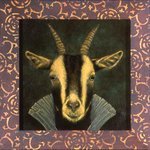
CB: Coming from New York City, I didn’t know anything about animals..I didn’t have a chance to be around them…I think I’ve always been a little scared of animals. A lot of my animals are dressed up, maybe to make them humorous and a little more friendly. Some look a little fierce. I’ve become more interested in birds because of painting birds..Now I’m really into bird watching. And the animals, who isn’t interested in animals?
SL: Your paintings – whether wild life or figurative – also reflects a strong medieval influence. How did that evolve?
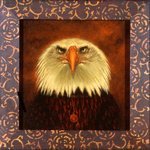
CB: Even as a child I would sit and stare at Van Eyke and Holbein paintings and be just fascinated with that period for some reason. After (Rollins) College, I painted everything until I latched onto this late medieval period, the 1500-1600s. Once I got there, some 25 years ago, I stayed.
SL: How did the medieval imagery develop in your figurative and animal imagery?
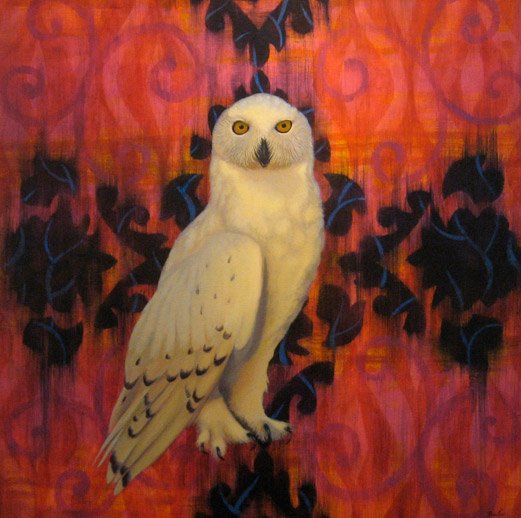
CB: I really started delving into that period when I painted the tapestries… I was designing the inside of a restaurant..Rococo’s..I decided to paint “tapestries” instead of murals on the walls. I say “tapestries” because they hung from iron bars but were painted on canvas. Some of them were actual portraits of present day people put into the medieval period. At the end of each painting, I’d think ‘maybe I’ll put a monkey down in this corner; maybe I’ll put a little dog over here..’ I became more interested in where I was going to insert the animals and that led to leaving the people out entirely.
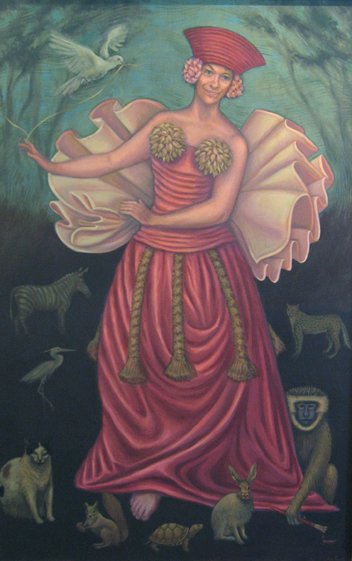
I started doing portraits of individual animals, sort of linking into the portraiture of the 1500s, paintings by Van Eyke or Holbein…I think animals are incredibly dignified looking. They need to get dressed up for their portraits. I also think they have another side you’re not seeing.
SL: How has technique also evolved in your work?
CB: For a long time I painted in acrylic and realized I just couldn’t get the colors I wanted to use. Oils are so luminous, especially dark colors. So I switched to oils.
SL: How do you see your work’s progression and where it may be headed?
CB: It’s always been realistic but has gotten to be super realistic and I think that just comes with better technique. I sort of long to get more abstract. I feel a little bit lately like I should break out of the tightness of realism and explore – not totally abstract – but some looser technique.
*********
John Grant
Photographer John Grant remembers buying his first camera in the early ‘70s while serving a three-year Navy stint on a large amphibious vessel during the Vietnam era. He and a highly trained graphic designer shipmate started shooting while visiting exotic port locations.
John Grant: We would go out on these photographic ventures all over the Orient because our ship went there. My newly purchased Pentax 35mm system was a remarkable deal given the currency valuation of the day…a tenth of what my high res Canon system costs here today. When I came back, I realized there wasn’t much of a way of making a living in photography but I still maintained my interest through all my business ventures including publishing, graphic design and management.
SL: Since I understand that you are a self-taught photographer, at what point, did you feel you could make photography your full time interest?
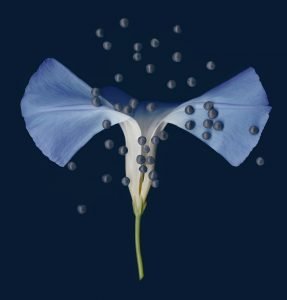
JG: About seven years ago, I was working at Crutchfield (as Creative Vice President), and I started putting my (flower) photographs up on my office walls. People responded so positively that it gave me the cue to see if I could expand it. And having an entrepreneurial background (and my children through with college), I just decided to jump out and do it.
SL: Your early flower photographs are so rich and luminous. What technique did you use to create this effect?
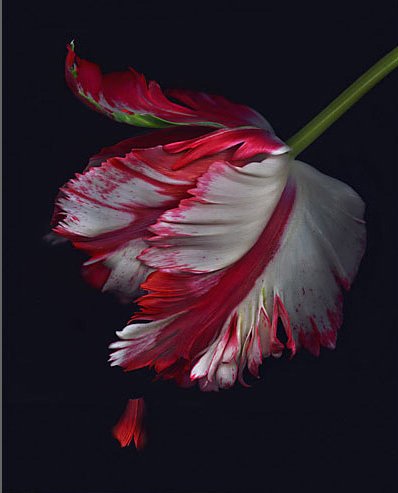
JG: I used a scanner instead of a camera. It gave a different point of view and the resolution on a scanner is greater than what you get on a camera, especially for macro, very close up work. I cut the flowers and put them directly onto the scanner. You don’t put the top down. Because of the contrast range and the brightness of the light, the background naturally comes out black and it created these phenomenally detailed, beautiful images. I’m very interested in flowers and botanicals so it combined those two interests. I never stopped experimenting. I was then able to expand (my work) using other programs, cameras, software and surface treatments.
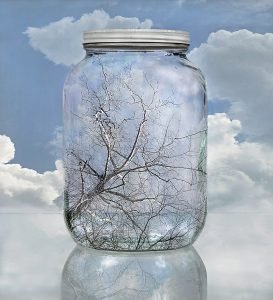
SL: Your next stage of work seems influenced by Surreal/Magritte imagery. How did you achieve its layered effect?
JG: I learned to do montage techniques using camera images combined with scanner images. Putting overlays of texture and overlays of different kind of imagery in the background allows you to use photography almost like you’re painting. My interest is in using photographic processes to create images that show more self-expression. The Surreal and Magritte-like images intrigue me both internally and externally.
SL: Grant next experimented photographing flowers immersed in liquid and ink dropped into water to fascinating effects. His latest work, “Monuments and Distant Memories,” is ever more nuanced and mysterious. What technique do you use for your latest work?
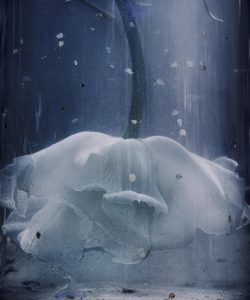
JG: Generically, it’s transfer work. I’ve learned that I can print an image onto a clear film and then put a special solution onto paper, put the film down and then it turns into an emulsion that transfers to paper, but with various flaws and “errors” and fascinating distortions.
SL: Your work seems to have literally grown darker. Is that a conscious choice?
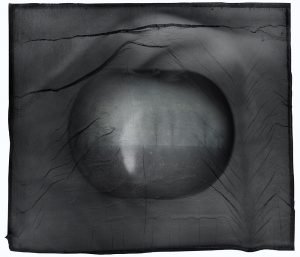
JG: The work is darker but partly because it tends to be essentially black and white…I don’t think I’m really darker…it’s part of what happens with this technique, but also I think we’re going through dark times and I may be reflecting that in some ways along with the issues that come with aging (couldn’t happen to me). The transfer work has the appearance of looking through a shroud of some sort. And that’s the way my memory is, recollections distilled as it were…I try to create images that seem significant, images that have real meaning and are not frivolous, and therefore some of the images are conceptually challenging. My goal and fascination is to do work that is a step beyond what we usually see.
For further works by Cynthia Burke and John Grant, visit art {issue no. 3}
–Elizabeth Meade Howard, Art Editor
Follow us!Share this post with your friends.
